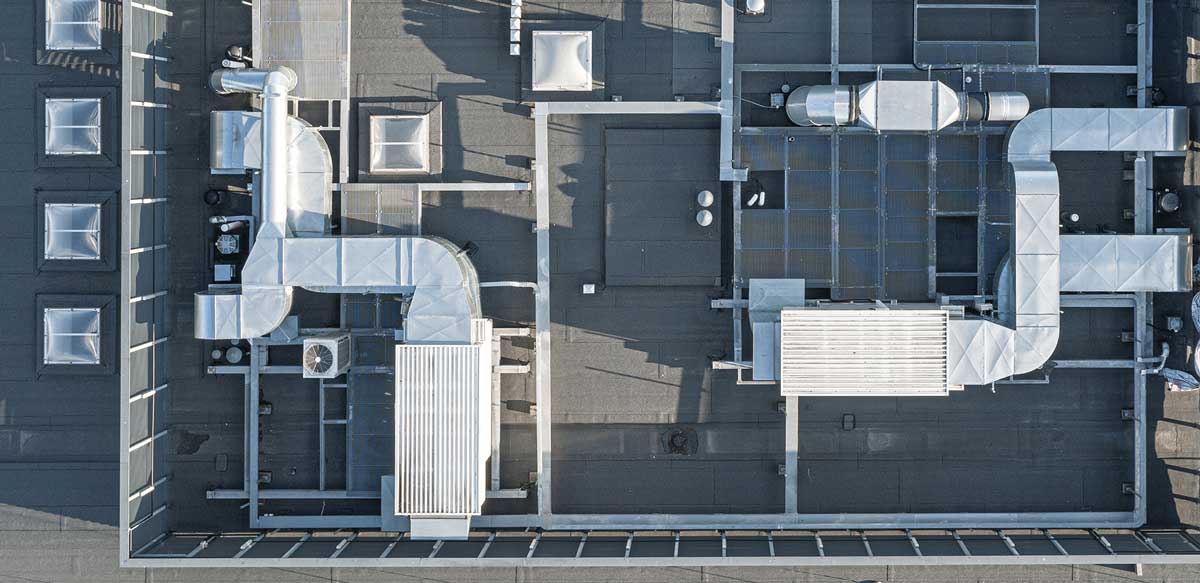Roofing Details Make a Difference: An Up Close Look at Your Roof's Components

Roofing season is upon us. With the turbulent weather we all experienced this winter, it's essential to truly understand how the past storms may have affected every component of your roof system. Paying close attention to roof components like drains, scuppers, flashings, pipes, pitch pans and more is vital for proper maintenance and ensuring that your roof will withstand the elements. Let's look closer at those items to understand their function and how to address their condition during your seasonal maintenance.
Commercial roof drainage systems, what to look for:
The drainage system of your roof is crucial in preventing ponding water, which can eventually cause leaks and damage. Ponding water may stress your entire roof system by adding unnecessary weight, deteriorating your roof’s surface, encouraging plant, algae or fungi growth, becoming breeding grounds for mosquitoes and attracting birds to nest on rooftops by providing a water source. Unlike steep-sloped roofs, where water can flow down the slope, flat and low-sloped roofs rely on drainage systems and scuppers to channel rainwater. It is essential to conduct regular inspections and cleaning of these to ensure proper water runoff.
✓ Drains:
A roof drain is a feature that channels water runoff from the roof through the interior of the building, using piping that discharges the water onto the ground or into a storm sewer. These projections are essential for flat roofs and are placed strategically around your roof to collect any ponding water in specific sections. Strainer baskets around those drains catch debris to prevent clogging of the system. To ensure optimal performance, it is important to regularly clean and inspect the drains and baskets, especially during the fall season when there is foliage, after storms and snowmelt. Clogged strainer baskets will result in ponding water, while damaged strainer baskets may also allow debris to travel down the pipe and clog the drain. In both cases, ponding water may result in water damage and additional stress on your roof.
✓ Scuppers:
A roof scupper is an architectural feature facilitating roof drainage by allowing water runoff at the edge of your roof. Like a roof drain, a scupper may get clogged by debris and cause ponding water. In cold climates, water may freeze at the scruppers as they are part of a wall and cannot take advantage of the building's interior temperature like a water drain would. It is imperative to ensure your scuppers are clean and unobstructed to prevent water from ponding or freezing around the roof's edges.
✓ Gutters:
Some commercial roofs may also have gutters, particularly steep-slope roofs. These channels are designed to collect water around the edges of your roof and are also prone to debris collection or freezing. If your commercial property has gutters, add gutter cleaning to your maintenance checklist to avoid drain system backup.
✓ Downspout:
This feature receives rainwater from drains and scuppers allowing it to flow to the ground or sewage. Clogged or frozen downspouts will prevent proper drainage and result in ponding water on top of your roof.
To ensure all your drain system elements are adequately cleaned and maintained, it is recommended to have a preventative maintenance plan. Explore various options here: Preventative Maintenance Page.
Keep it sealed, check the condition of all flashings and pitch-pans:
✓ Flashings:
When the roof membrane meets a vertical surface like a wall, vent or HVAC, there's an opportunity for water intrusion. To prevent that, commercial roofers install flashing, a strip or panel of roof membrane to protect that seam. Over time, roof flashings are exposed to multiple factors like extreme temperature, freeze-and-thaw cycles, damage from an impact (for example, during a storm), wind uplift stressing the entire roof system and so on. When those factors finally cause separation, water can penetrate the roof assembly. Checking the integrity of your flashings with a commercial roofing professional from CentiMark is an essential part of your preparation for the upcoming storm and hurricane season. Request a comprehensive roof evaluation to ensure flashings around the roof's edge and rooftop projections are in good condition.
✓ Pitch-pans and pitch-pockets:
These are metal containers with a sealant that wraps around various roof penetrations to ensure waterproofing. If your facility has roof penetrations, you are more likely to find those features on your roof. With age, temperature extremes, vibration or pressure from projections, pitch-pans and pockets may experience various issues, from a shrinking sealant to shifting. Once the seal is compromised, water can penetrate your building around the projection. A roof maintenance plan that includes regular roof evaluations and timely repairs is the best way to prevent this from happening.
Why paying attention matters:
Regular maintenance of drains, flashings and other roofing details is essential for preventing leaks and protecting the integrity of your building. Addressing wear and tear promptly can significantly extend the life of your roof, saving you costs in the long run. The health of your roof lies in the details. By understanding, inspecting and addressing these components, you prepare your building to face the elements and ensure a resilient structure for years. If you have any questions or want to schedule a detailed roof evaluation, contact us today! We're here to assist you in preparing your roof for the challenges ahead.
When you subscribe to the blog, we will send you an e-mail when there are new updates on the site so you wouldn't miss them.
We use cookies to improve your experience on our website. By clicking "I accept" or continuing to use our site, you consent to the use of cookies unless you have disabled them. Learn more here: Privacy Policy and CCPA.
